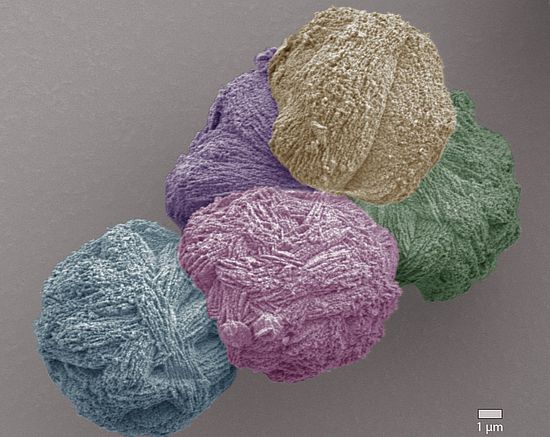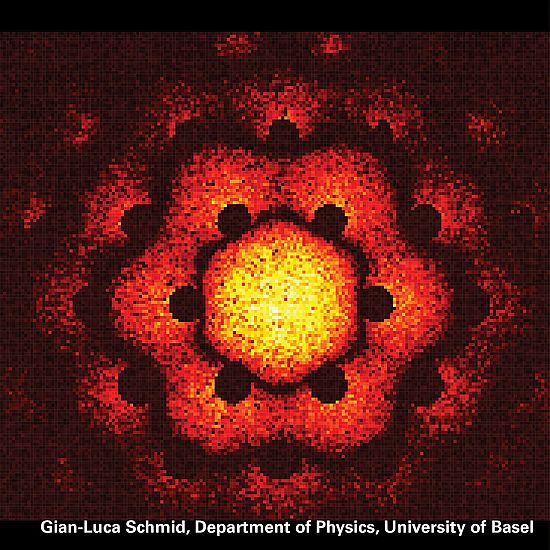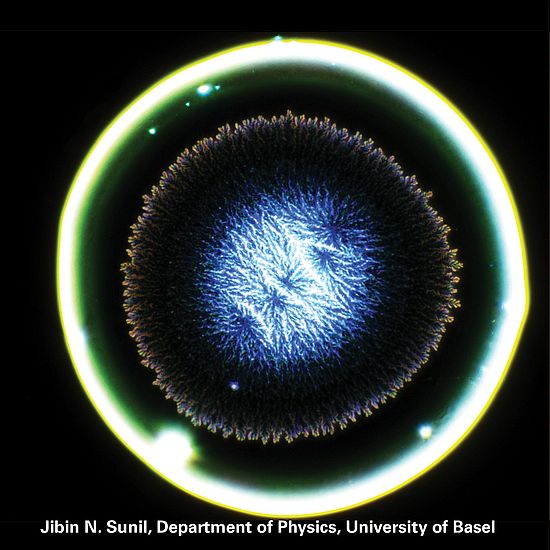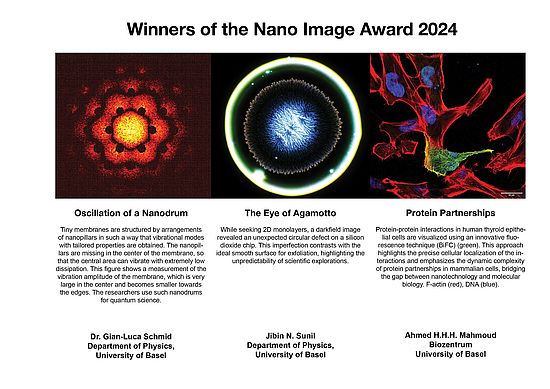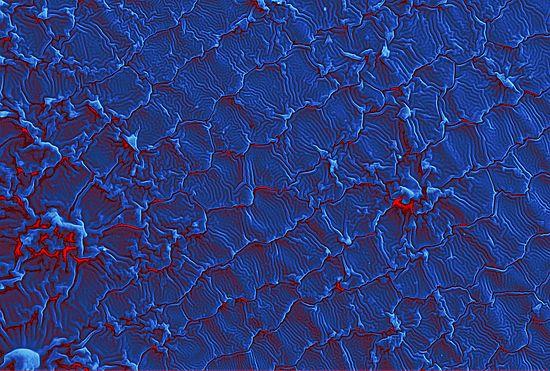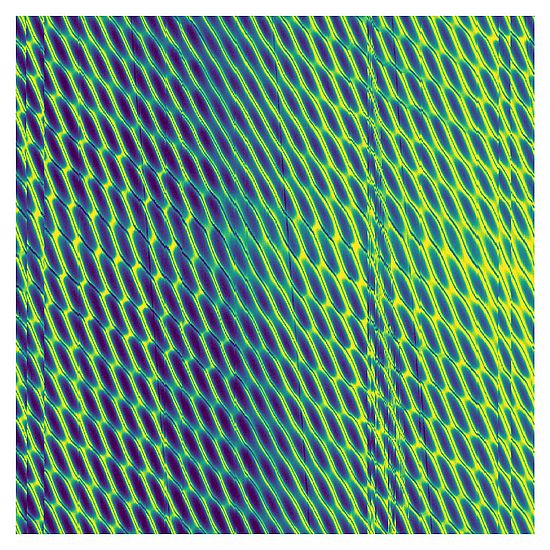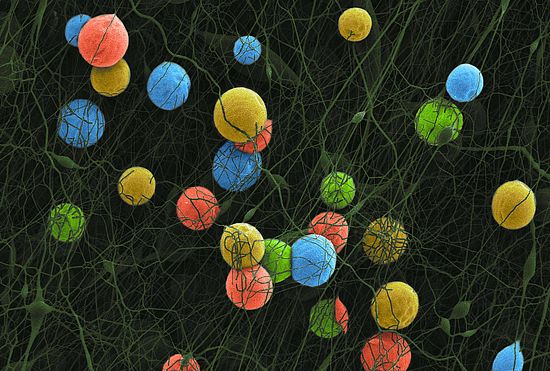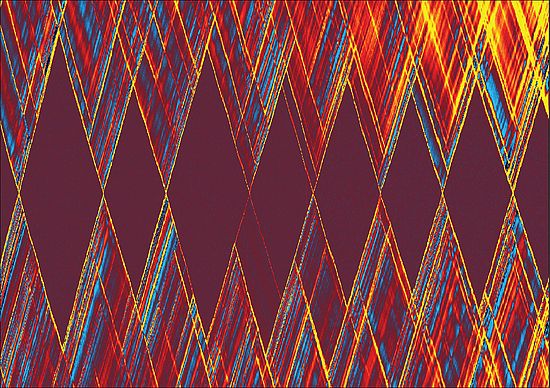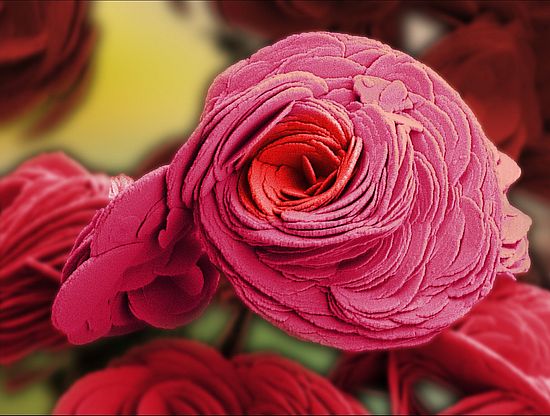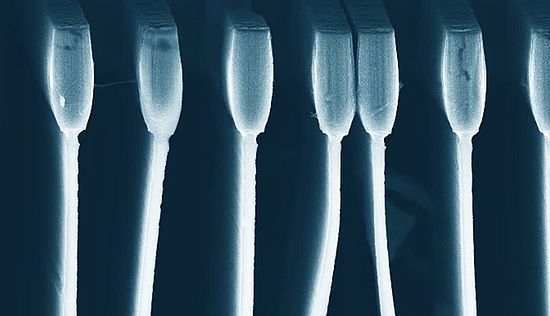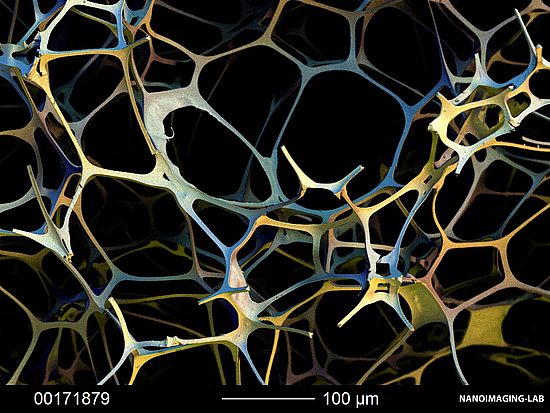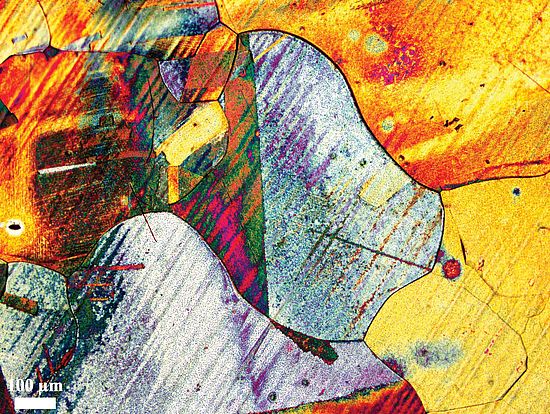Nano Image Award
Nano Image Award 2025

A single tungsten diselenide triangle on graphene/ silicon carbide (SiC) breaks down into triangles within triangles, forming nested facets. The AFM height map (tapping mode) shows the pattern, and the diagonal bands trace the SiC step terraces that guide growth. Ángel Labordet (Empa and SNI, University of Basel)
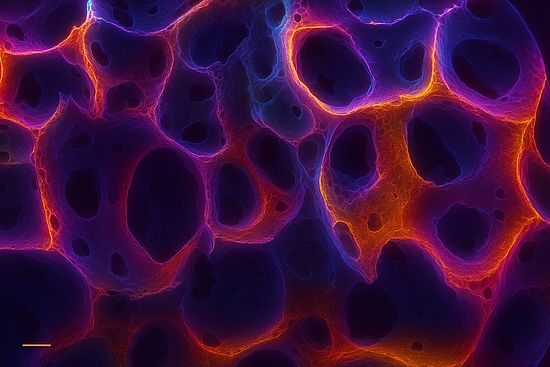
The open-pored structure consists of natural albumin and forms a stable, biocompatible protein network. Its highly cross-linked pore structure provides an optimal microenvironment for cell adhesion and tissue integration, making it a promising scaffold for bone and cartilage regeneration. (Scale: 100 µm) Sven Zaugg (University of Applied Sciences and Arts, FHNW)



Nano Image Award 2023
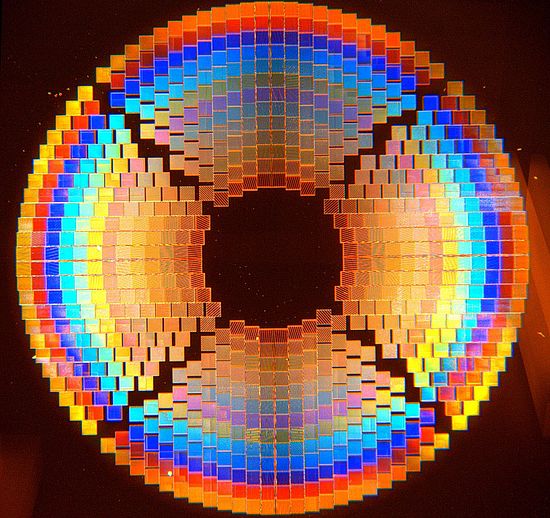
An X-ray condensing beamshaper, captured under a light microscope. Its intricate geometry diffracts visible light, unveiling a spectrum of radiant colors, where each hue signifies a unique line periodicity. The diameter of the beamshaper is 2 mm, and the thinnest linewidth is 50 nm. The device was developed for the X-ray microscope operated by the Hereon Research Center, Germany. Peng Qi, Joan Vila-Comamala, Di Qu Paul Scherrer Institute
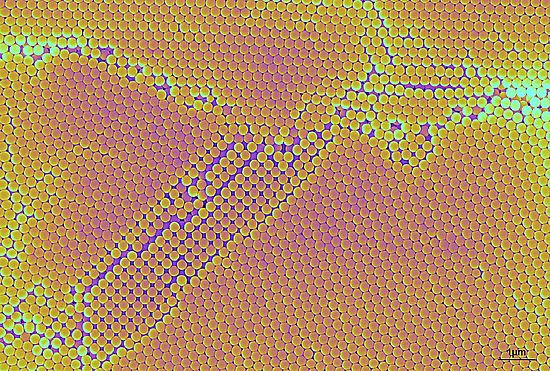
Microspheres were prepared from styrene via emulsion polymerization by students in the practical training in polymers at FHNW. The spheres are forming hexagonal ordered assemblies when dried on the sample holder. The image was taken with an Electron microscope. The spheres are originally white, the image was colored using Adobe Photoshop. Vivien Hollenstein, Laura Martinez and Sina Saxer FHNW School of Life Sciences
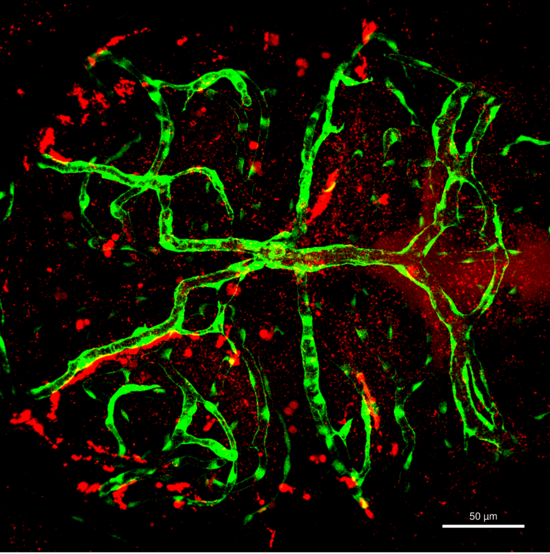
View of the mid-brain region of a zebrafish larva under a confocal microscope, visualizing the green endothelial cells of the vasculature that build up the blood-brain barrier (green). Red fluorescent tracers leaving the green vasculature indicating leakage of the blood-brain barrier in the presence of toxic agents. Ramya Deepthi Puligilla Department of Pharmaceutical Sciences, University of Basel



Nano Image Award 2022
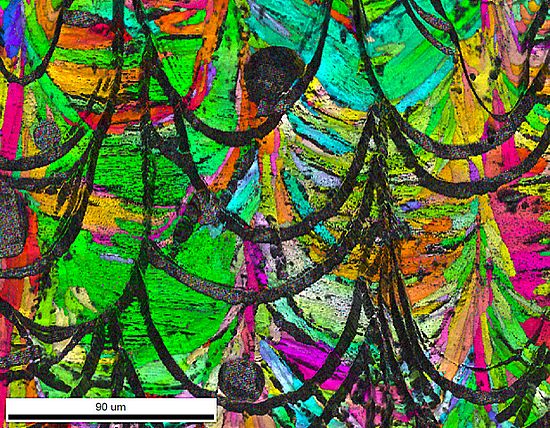
Electron Backscatter Diffraction color crystal orientation map of a 3D-printed (additively manufactured) stainless steel, after etching the surface to reveal the melt pool tracks. The material is porous (pores seen as black dots at the tips of the meld pool tracks) which interrupts the epitaxial growth of the crystallites in the material during solidification. Therefore every melt pool consists of several small crystallites with different orientation. Dr. Efthymios Polatidis and Christos Sofras Laboratoy for Neutron Scattering and Imaging (LNS), Paul Scherrer Institute
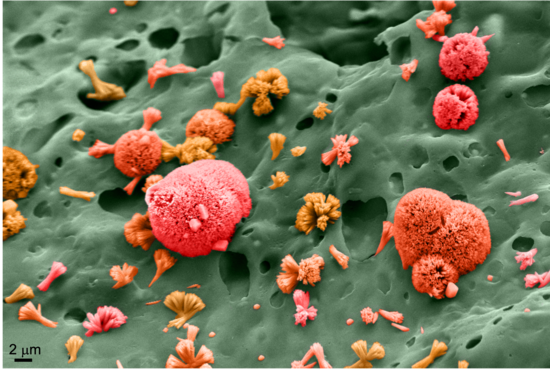
Grown crystals of fluorapatite on a treated toothsurface. The image was made in preparation of a publication that covers also the results from the Nano Argovia project Nanocure. Dr. Lucy Kind, FHNW School of Life Sciences, Muttenz
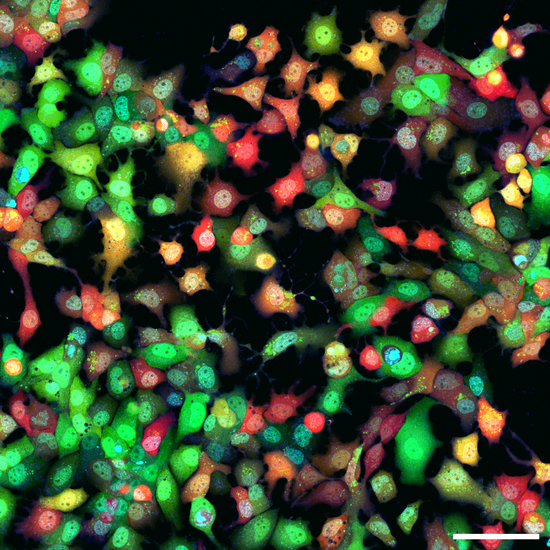
Analysis of human cells expressing a red fluorescent transgene by confocal microscopy. Cells were transfected using a lipid-nanoparticle (LNP) based gene delivery system. Bright green signal: endosomal escape, green signal: Galectin3-GFP, red signal: transgene RFP, cyan signal: cell nuclei, blue signal: LNP Claudio Alter, SNI PhD-School, Department of Pharmaceutical Sciences, University of Basel



Nano Image Award 2021
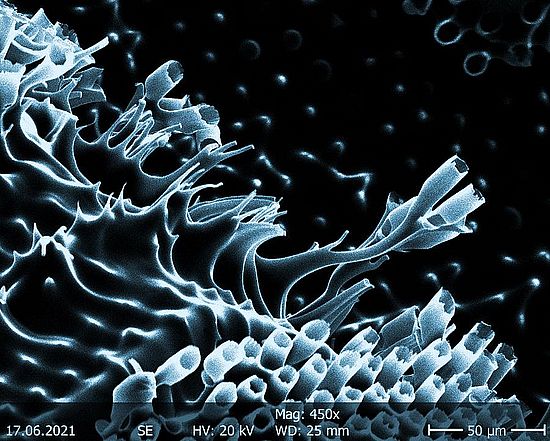
Christmas candles - Scanning electron microscopy image of artifact structures on a hot-embossed polymer film Manuel Kraus (CSEM Center Muttenz)



Nano Image Award 2020
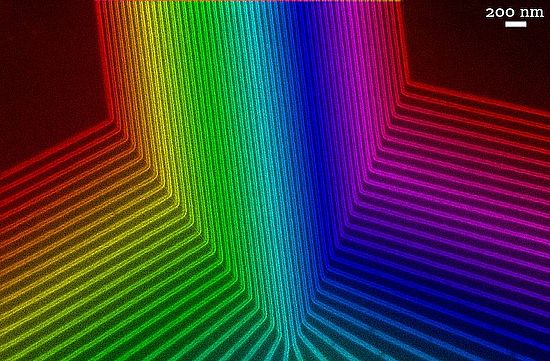
Gate Array Rasterelektronenmikroskopische Aufnahme von Teilen einer Spin-Qubit-Vorrichtung, die durch Elektronenstrahl-Litho- graphie hergestellt wurde. Sie ist in Regenbogenfarben eingefärbt, weil sich die Strukturen in einem Abstand, der etwas kleiner als die Wellenlänge des sichtbaren Lichts ist, anordnen und sich daher je nach Betrachtungswinkel in unterschiedlichen Farben zeigen. Jann Hinnerk Ungerer SNI PhD Student Departement Physik, Universität of Basel
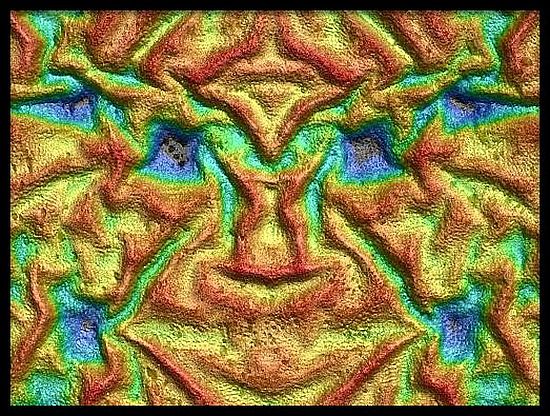
INKA Maske Konfokales Laser-Scanning-Mikroskopie-Bild eines Lacks auf einer PET-Folie, abgeformt von einer laserstrukturierten Stahlvorlage Maßstab: 280 µm x 210 µm x 16 µm Das Bild ist das Ergebnis einer Zusammenarbeit zwischen der ALPS (Berner Fachhochschule) und INKA, FHNW Dr. Laurent Feuz Institut für Nanotechnische Kunststoffanwendungen (INKA), FHNW
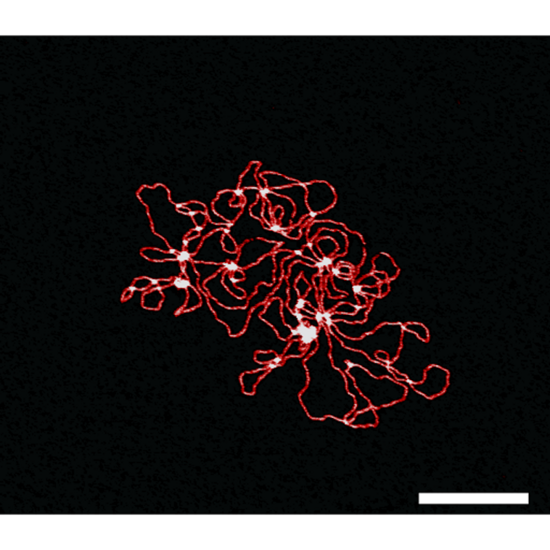
Verwicklungen Rasterkraftmikroskopische (AFM) Topographie-Aufnahme einer doppelsträngigen DNA (dsDNA) Die eingefärbten und verschlungenen, fadenartigen Strukturen sind die dsDNA-Fragmente. Der Hintergrund ist der frisch gespaltene Glimmer, an den die DNA-Fragmente adsorbiert wurden. Maßstabsbalken, 180 nm. Selen Manioglu PhD Student ETH Zürich/D-BSSE, Biophysics Lab
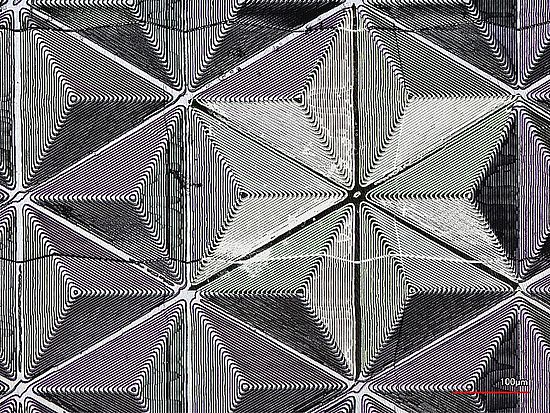
Weihnachtsstern Oberflächen-Topologie einer Entblendungsfolie, die für Beleuchtungslösungen verwendet wird. Die Charakterisierung wurde mit einem konfokalen Laser-Scanning-Mikroskop durchgeführt, und Teile des sich wiederholenden Musters wurden neu eingefärbt. Das Bild ist das Ergebnis einer Zusammenarbeit zwischen CSEM Center Muttenz und INKA, FHNW.Tamara Aderneuer SNI PhD Student Micro-Nano Optics, CSEM Muttenz




Nano Image Award 2019
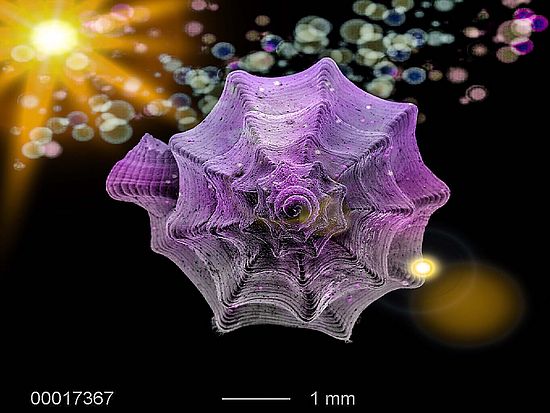
Lepicythara - Not really Nano but still very small and extremly attractive: a tiny snail from the genus Neogastropoda Daniel Mathys, Nano Imaging Lab, Swiss Nanoscience Institute, University of Basel



Nano Image Award 2018
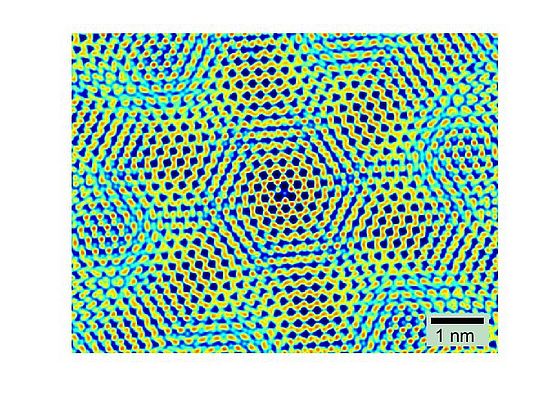
Artificial crystals in two dimensions - Illustration of the periodic potential structure that forms when a single layer of carbon atoms (Graphene) is combined with two layers of Boron Nitride, one on top, one at the bottom, at different angles. Effects of such artificial crystal structures can be found in electronic devices fabricated in the Nano-electronics group at the University of Basel.- Andreas Baumgartner Department of Physics, University of Basel



Nano Image Award 2017
Nano Image Award 2016
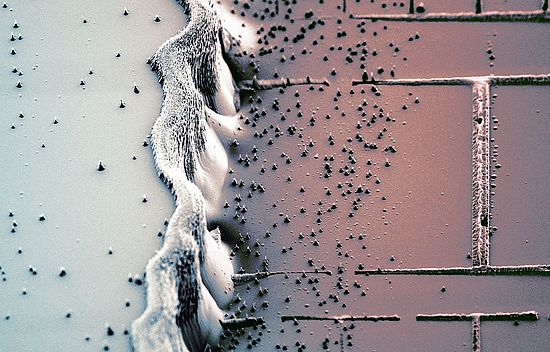
Marietta Batzer, Dominik Rohner (Physics Department, University of Basel) Winter landscape. Diamond surface after etching with a plasma (rectangular paddles can be broken out and used as samples)



Nano Image Award 2015

Gulibusitan Abulizi: A real-color optical microscope image of an hexagonal boron nitride flake on a silicon oxide substrate The observed optical colors are due to interference effect, which can be used to determine the hexagonal boron nitride (hBN) flake thickness. Here, the observed color progresses from violet to blue, to green, to yellow, to orange, and to red, while the hBN flake thickness increases.




Nano Image Award 2014

Graphene Mosaic, Kishan Thodkar (University of Basel) The image was taken after the Chemical Vapour Deposition process of graphene on copper foil. After the growth, the foil was heated to 200°C for a minute to optically visualize regions of copper foil uncovered by graphene.

Virus-imprinted nanoparticles, Patrick Shahgaldian (FHNW), colorised by Martin Oeggerli (micronaut.ch). It is a color SEM micrograph of our virus-imprinted nanoparticles

We caught the rainbow, Celestino Padeste (PSI) Water contact angle measurement on a nanostructured nickel master (5 cm in diameter) functionalized with an anti-sticking coating. The structured area consists of an array of pillars of 300 nm diameter with 600 nm period. (Collaboration FHNW/PSI/EULITHA/Applied Microswiss)



Nano Image Award 2010
Nano Image Award 2010

Wang Li, CSEM SEM images of the controlled positioning of Silver nanoparticles, which form nanoflowers and nanoleaves.

Markus Weiss Dark Field Image of sample that consists of a Carbon Nanotube Josephson Junction in an engineered electromagnetic environment.

Barbara Rothen, Uni Bern (Gruppe Gehr) Fluoreszenzmarkierte Liposomen (rot) mit einem Nanopolystyrolpartikel (gruen) innerhalb der Liposomen.

Enrico Gnecco "Lateral force map of the superstructure formed by an ultrathin KBr film deposited on NaCl" The frame size is 10 nm and the image was published in Phys. Rev. B 78 (2008) 045432 (authors: S. Maier, E. Gnecco, A. Baratoff, R. Bennewitz, and E. Meyer)

Christian Held SEM picture of tungstenoxide crystals on EPOXY glue. While examine the tungsten etched AFM/STM tips these nice structures were found. I admit not really nano, but still very nice.

Fabian Itel A fluorescence light microscope picture of a fluorescently labelled polymer-lipid mixtur monolayer.

André Kaufmann Die Bilder zeigen Felder von Nanotürmen mit einem Durchmesser von 170 nm und einer Höhe von 250 nm. Die Türme selber bestehen aus SiO2 (oberer Teil) und Si (unterer Teil) wobei sich die Grenzfläche auf einer Höhe von 60 nm befindet. Die Felder wurden gezielt mit einem SFM manipuliert um gewisse Strukturen abbilden zu können. Das Bild wurde im Anschluss an die Manipulation mit derselben Technik aufgenommen. Um die geschriebenen Strukturen sehen zu können, sollte man die Bilder ein wenig aus der Ferne betrachten. PS: Nebst PSI, SNI und IU (seinerzeit für meine Freundin geschrieben) hätte ich auch noch NCCR und LMN im Angebot.

André Kaufmann Die Bilder zeigen Felder von Nanotürmen mit einem Durchmesser von 170 nm und einer Höhe von 250 nm. Die Türme selber bestehen aus SiO2 (oberer Teil) und Si (unterer Teil) wobei sich die Grenzfläche auf einer Höhe von 60 nm befindet. Die Felder wurden gezielt mit einem SFM manipuliert um gewisse Strukturen abbilden zu können. Das Bild wurde im Anschluss an die Manipulation mit derselben Technik aufgenommen. Um die geschriebenen Strukturen sehen zu können, sollte man die Bilder ein wenig aus der Ferne betrachten. PS: Nebst PSI, SNI und IU (seinerzeit für meine Freundin geschrieben) hätte ich auch noch NCCR und LMN im Angebot.

André Kaufmann Die Bilder zeigen Felder von Nanotürmen mit einem Durchmesser von 170 nm und einer Höhe von 250 nm. Die Türme selber bestehen aus SiO2 (oberer Teil) und Si (unterer Teil) wobei sich die Grenzfläche auf einer Höhe von 60 nm befindet. Die Felder wurden gezielt mit einem SFM manipuliert um gewisse Strukturen abbilden zu können. Das Bild wurde im Anschluss an die Manipulation mit derselben Technik aufgenommen. Um die geschriebenen Strukturen sehen zu können, sollte man die Bilder ein wenig aus der Ferne betrachten. PS: Nebst PSI, SNI und IU (seinerzeit für meine Freundin geschrieben) hätte ich auch noch NCCR und LMN im Angebot.

Mona Klein, CSEM "Waferscale-production of Bienenwachskerzen - just in time for christmas" Also Si pillars, etched with a modified procedure. The "flame" is due to residues of the polystyrene beads which where used to pattern the SiOx hard mask.

Mona Klein, CSEM "Waferscale-production of Bienenwachskerzen - just in time for christmas" Also Si pillars, etched with a modified procedure. The "flame" is due to residues of the polystyrene beads which where used to pattern the SiOx hard mask.

Mona Klein, CSEM Si pillars etched with a Bosch-like process using a SiOx mask patterned by self-assembled polystyrene beads stick their heads together due to charging in the SEM.

Andrea Lehmann, Uni Bern (Gruppe Gehr) Makrophagen (weiss, transparent, markiert ist das Aktin-Zytoskelett) mit intrazellulaeren Eisenplatin-Nanopartikeln (rot, fluoreszenzmarkierte Huelle).

Marko Loparic Individual female chromosomes (from 6th to 13th chromosomes) isolated from blood and imaged with the AFM. Single GTG bands (chromatin condensates as bright bands) are detected without additional staining. Moreover, nanometer substructures of single chromosomes (hairy edges) are clearly resolved. Chromosomes are isolated in the group of Dr. Kathrin Hoffmann (University Hospital, Charité Berlin).

Marko Loparic Surface of the native cartilage imaged in quasi physiological conditions (PBS buffer) without staining or fixation. Collagen network is clearly resolved as rod like structures surrounded by aggregations of the proteoglycans.

Nicholas Minder Scanning electron micrograph of a hybrid graphene device, which was fabricated during my master's thesis in the group of Christian Schönenberger (supervisor: Jelena Trbovic). The device consists of ferromagnetic (Cobalt, yellow) and superconducting electrodes (Aluminium, red) over mechanically exfoliated graphene (blue) on a 300nm SiO2/Si wafer (gray). The electrodes were fabricated by electron beam lithography and thermal evaporation.

Jérôme Wiss Picture taken with STM at room temperature. It shows a hexagonal assembly of a porphyrin (called TV151) on Ag111. The picture has dimensions of 14.8nm*14.8nm. The pores are filled also with TV151 that is probably rotating in the pores

Ana-Maria Popa Open_sesam is the in-situu monitoring by AFM in liquid media of the conformation change of a responsive polymer covalently grafted to a nanoporous surface upon a temperature sweep. Nano_english gardens is an SEM image of a micro-nanostructured surface fabricated by block-copolymer assisted lithography.




































Internal Nanopic Award 2005
Quick Links

